This is our step-by-step guide on how to dehydrate white rice. Dehydrating white rice is easy to do and great to have.
Dehydrating rice is a simple process that can help make your homemade dehydrated camping meals even more enjoyable by adding more variety and options. We can cook white rice in a stock or broth to make it even more flavorful. Cooking rice in stock or broth is a simple way to elevate its taste and make it a more flavorful meal ingredient.
Dehydrating cooked rice makes it lighter, takes up less space, and has a longer shelf life. More importantly, the dehydrated rice becomes more like instant rice. It rehydrates and cooks much faster.
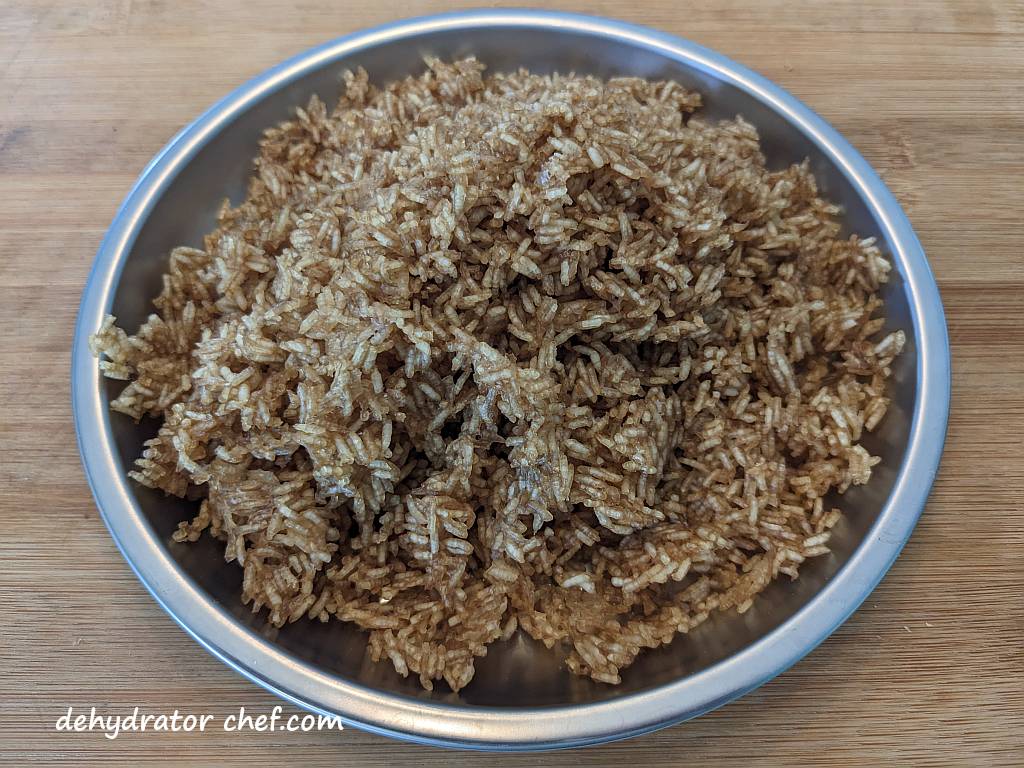
Even if you’ve never dehydrated anything before, don’t worry; dehydrating rice is a simple process that anyone can do with just a few basic tools that we will discuss here.
So, let’s get started dehydrating white rice.
Table of Contents
- How to Dehydrate White Rice
- Supplies Needed for Dehydrating White Rice
- Step 1. Process the White Rice for Dehydrating
- Step 2. Preparing the Dehydrator for Dehydrating White Rice
- Step 3. Dehydrating the White Rice
- Step 4. When is the Dehydrated White Rice Done
- Step 5. Equalizing and Conditioning of the Dehydrated White Rice
- Step 6. Storing Dehydrated White Rice
- Hydration
- Weights, Measures, and Serving Sizes
- Insider Tips
How to Dehydrate White Rice
There are a lot of white rice options from which to choose. For today’s dehydration project, we’ll use an inexpensive enriched long-grain white rice from the local grocer down the street.
We also have a page on dehydrating brown rice, check it out here. We separated the two posts since brown rice and white rice have different storage requirements. Properly stored, dehydrated white rice can remain viable for a year or more. Dehydrated brown rice, due to its higher oil content, will last for several months before getting rancid when properly stored.
We use dehydrated white rice in many of our homemade dehydrated backpacking meals. Taking the time now to dehydrate rice can create future food options.
Supplies Needed for Dehydrating White Rice
You will need a good quality food dehydrator to dehydrate white rice. We use the Nesco FD-75A, and you can check out our food dehydrator guide here and why we think Nesco offers the best bang for the buck. We believe this is the best food dehydrator for our long-term food storage needs.
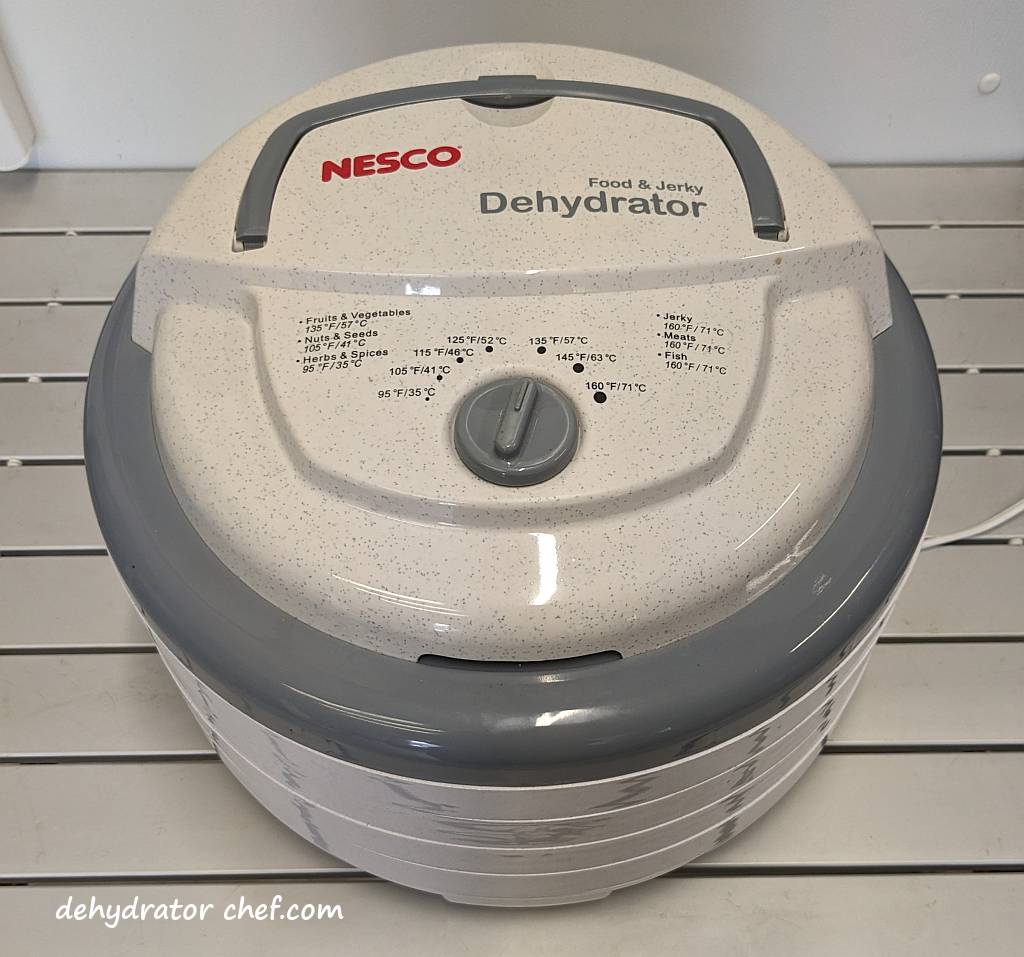
- A good quality white rice
- A flavorful stock or broth, today we are using a no-fat, low-sodium beef stock
- Food dehydrator with removable fruit roll sheet inserts, one for each tray
- Standard kitchen tools, including cutting boards, chef’s knife, spatula, etc.
- Clear canning jars with tight-fitting lids
- Wide-mouth canning jar funnel
- Desiccant packets
For planning purposes, 1 cup of cooked white rice will fill one Nesco FD-75A dehydrator tray. So, we’ll need about seven trays for one 16-ounce bag of our long-grain rice, which makes about 7 cups of cooked rice.
You’ll also need removable fruit roll sheet inserts; one will be needed for each of the dehydrator trays.
Step 1. Process the White Rice for Dehydrating
We are going to start by cooking the rice according to the preparation directions on the bag.
Generally, for every 1 cup of uncooked white rice, you will need 2 cups of water or stock, and you’ll have close to 3 cups of cooked rice product. For today’s project, we are using the entire bag, 16 ounces, and a 32-ounce carton of no-fat, low-sodium beef stock.
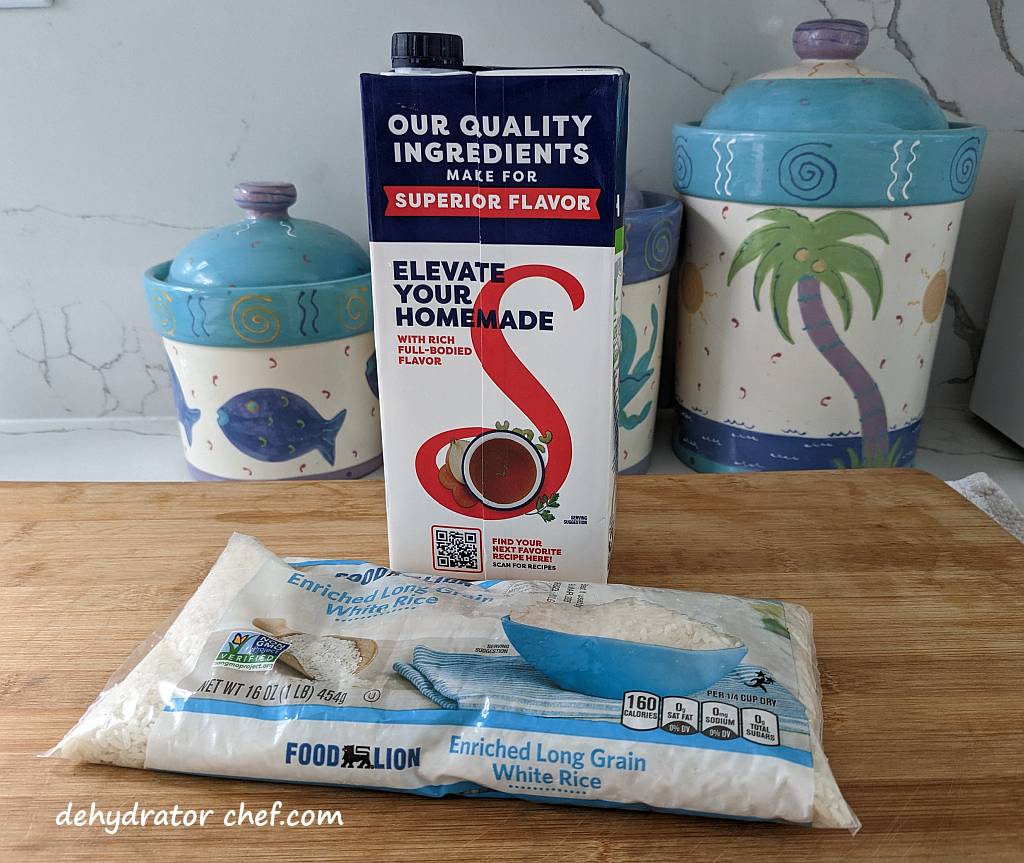
We’ll start by rinsing the white rice using cold water to remove any surface starch or dust. Rice grains contain starch on their surface, which can make the cooked rice sticky or clumpy. Rinsing the rice helps remove some, but not all, of the starch.
We’re also inspecting the rice and removing anything that shouldn’t be there.
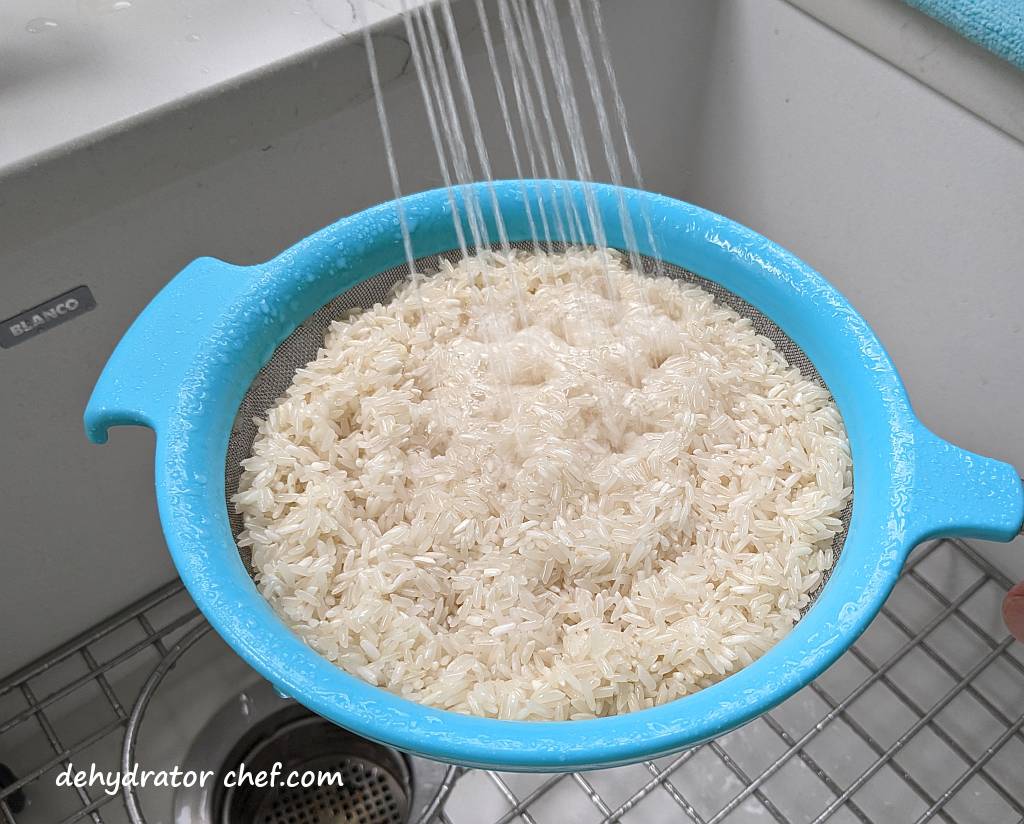
It is generally advised to rinse rice; however, certain types of rice, like sushi rice or risotto rice, may require different preparation methods that involve preserving the starch. If you are using such rice, you will need to modify the instructions accordingly.
Mix the stock and rice in a saucepan according to the package directions. Skip adding butter, even if it’s on the package directions.
Bring to a boil.
Reduce heat to a simmer, cover the saucepan with a tight fitting lid. Simmer for 15 to 20 minutes or until all the liquid has been absorbed.
Remove from the heat and then fluff with a fork.
Step 2. Preparing the Dehydrator for Dehydrating White Rice

We cooked the entire 16-ounce bag of white rice according to package directions and ended up with close to 7 cups of the finished product.
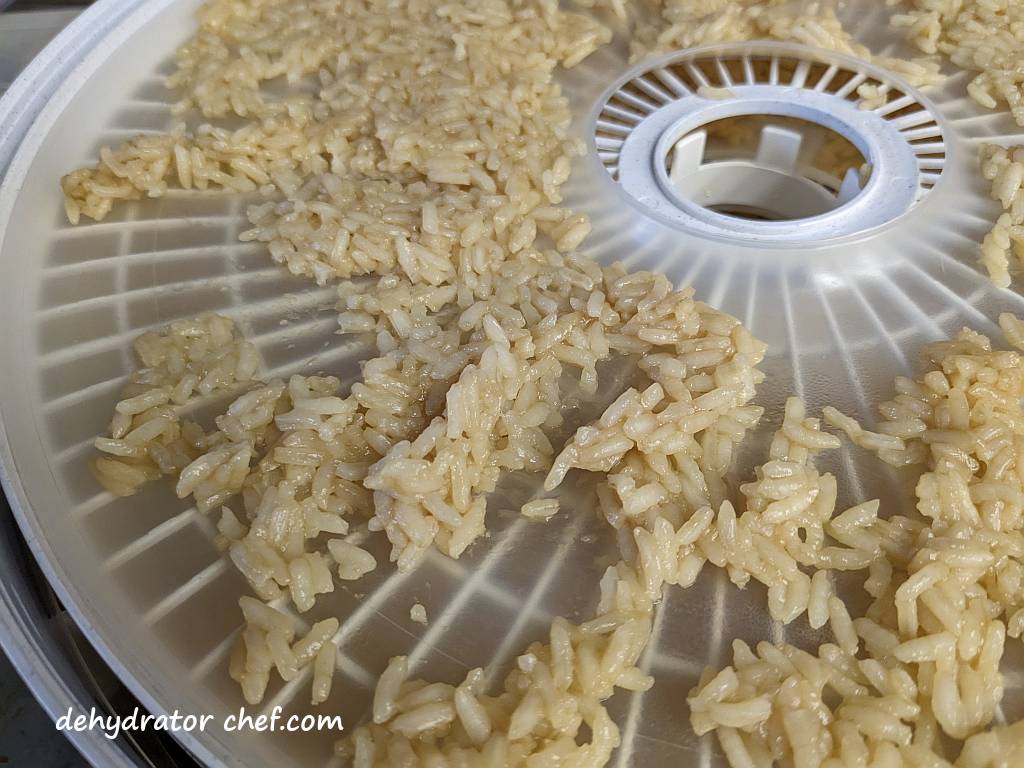
One cup of cooked white rice will fill one Nesco FD-75A dehydrator tray with the removable fruit roll sheet insert. Spread the cooked rice into a thin layer to promote even drying. A spatula works well here. The cooked rice will most likely stick together in clumps as you layer it on the fruit roll sheets. We can fix the clumping problem later.
Step 3. Dehydrating the White Rice
Set the dehydrator thermostat temperature to 135 °F / 57 °C. I find that 18 to 24 hours is about the right amount of time for dehydrating rice. Drying times are variable and dependent on your food dehydrator, the ambient temperature and humidity, the number of dehydrator trays, the size of food items, and how crowded you fill your dehydrator trays.
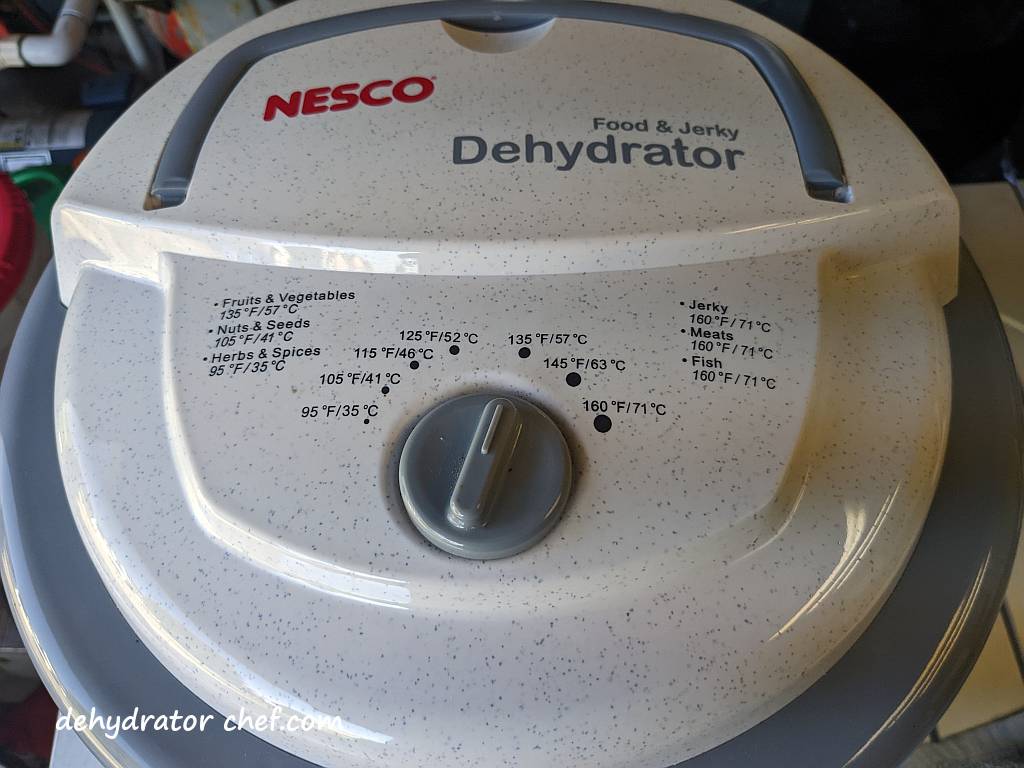
Case hardening is a phenomenon that can occur during the drying process of certain foods, including rice. It refers to the development of a hard outer crust or surface layer on the food, which can prevent the escape of moisture from the interior. This can lead to uneven drying and potentially result in moisture retention within the rice grains.
The outer layer of the rice clumps may dry quickly and prevent the inside moisture from escaping, otherwise known as case hardening. About mid-way through the drying process, break apart any rice clumps into smaller pieces to prevent case hardening.
Step 4. When is the Dehydrated White Rice Done
The dehydrating rice will tend to shrink and break apart into sections. Pick up and examine the rice clumps’ top and bottom, looking for any sign of moisture or areas of undried rice. If seen, just let it dehydrate for another few hours and check again.
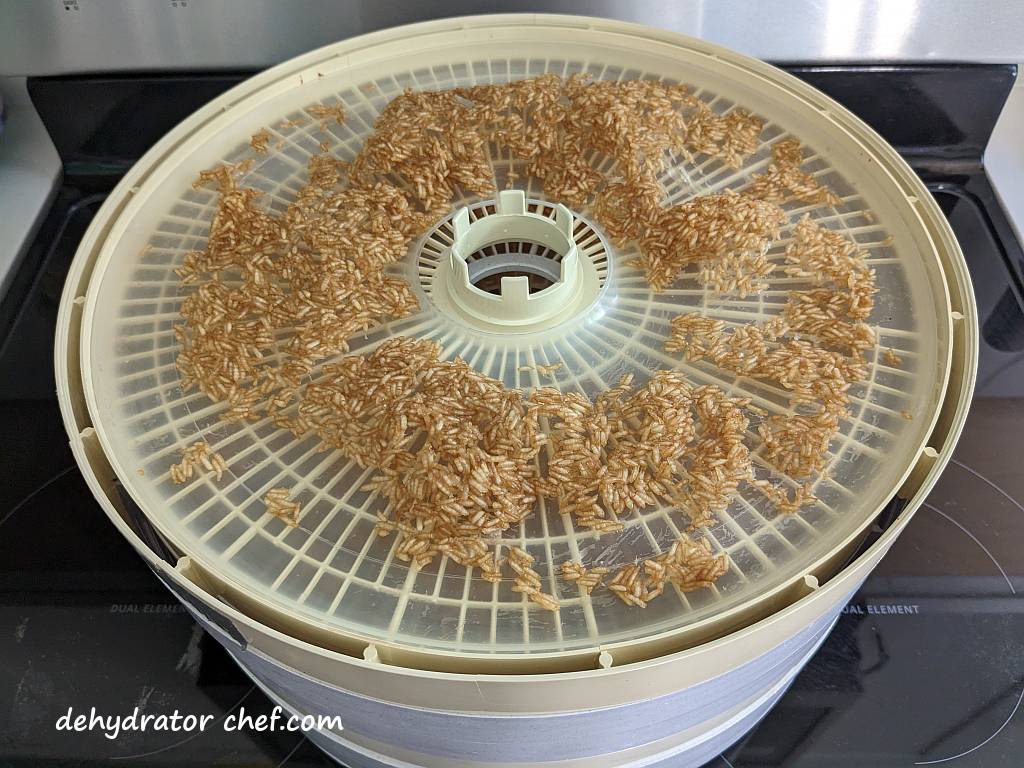
Drying times depend on your food dehydrator, the ambient temperature and humidity, the number of dehydrator trays, the size of food items, and how crowded you fill your dehydrator trays. Refer to your dehydrator owner’s manual for recommended temperatures and times for dehydrating specific foods. Remember to use drying times as a guide.
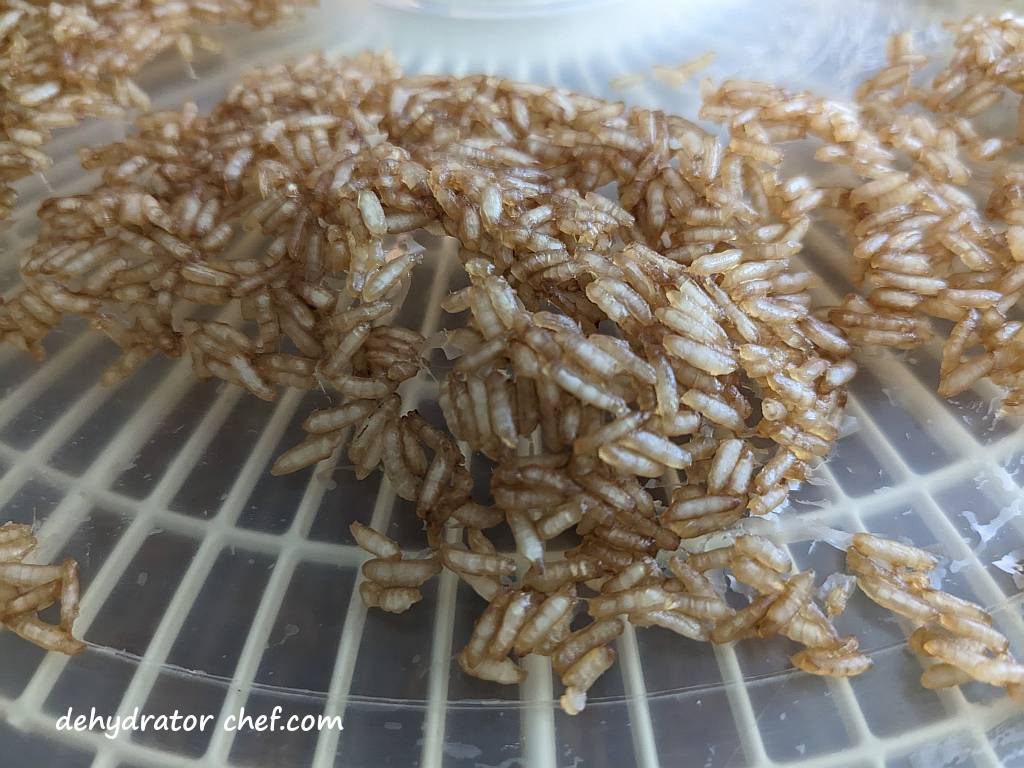
Dehydrated white rice is done when it easily breaks apart into smaller pieces. Any clumps have been broken down and checked for dryness.
With experience, you’ll develop an eye for this, but until it develops, check it all for dryness.
Step 5. Equalizing and Conditioning of the Dehydrated White Rice
When the dehydrated rice pieces are removed from the dehydrator, the remaining moisture may not be distributed equally among the pieces because of their location and position in the dehydrator. Equalizing and conditioning is a process for freshly dehydrated foods that ensures any residual moisture remaining in any piece is spread or equalized among all the other pieces in the batch. Let the dried rice equalize and condition in the storage container for 7 to 10 days.
We always recommend letting food items cool completely after they have finished dehydrating and before packing them into an airtight storage container for equalizing and conditioning. Warm food may cause sweating, which could provide enough moisture for mold to grow.
It does not take long for dehydrated food items to start hydrating from ambient household humidity. Do not leave dehydrated food items exposed to the elements any longer than necessary because of the increased risk of mold growth.
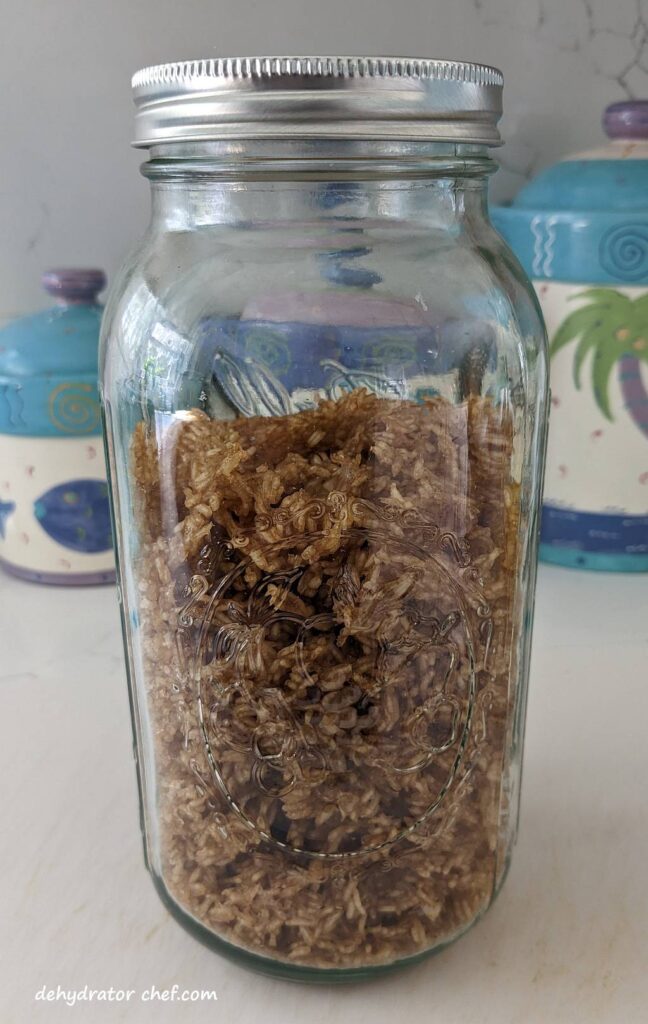
After a short cooling period, loosely pack the dehydrated rice into a clean, dry, insect-proof, and airtight storage container. We use the larger quart-size canning jars for conditioning. Since the canning jars are clear, it’s easy to see what’s inside. Fill the jars at most 2/3 to 3/4 full, leaving some headspace.
Headspace is the distance between the food surface and the lid’s underside. Its purpose is to provide ample space for the dehydrated food product to slide and tumble when shaken and rotated to expose any evidence of clumping or sticking.
A quality stainless steel or plastic canning funnel makes the messy job of getting dehydrated foods off the dehydrator tray removable inserts and into the canning jars an easy task. Take a minute or two and check them out here on Amazon.
Every day, check the jar for moisture. Roll the jar contents around and note any clumping or sticking. If seen, put the contents back on the dehydrator for several more hours. Since canning jars are clear, it’s easy to see what’s inside.
Lastly, if you notice any mold, even the tiniest bit, throw it all out. The mold spores you see are blooming enough to make them visible. But there are more, even smaller mold spores in the rest of your jar that make your dehydrated food inedible. Toss it all out and start another batch.
Step 6. Storing Dehydrated White Rice
Use an appropriately sized canning jar for storage. The dehydrated white rice might keep up to 12 months or longer. Exactly how long depends on how well you dehydrate the rice and your pantry storage conditions.
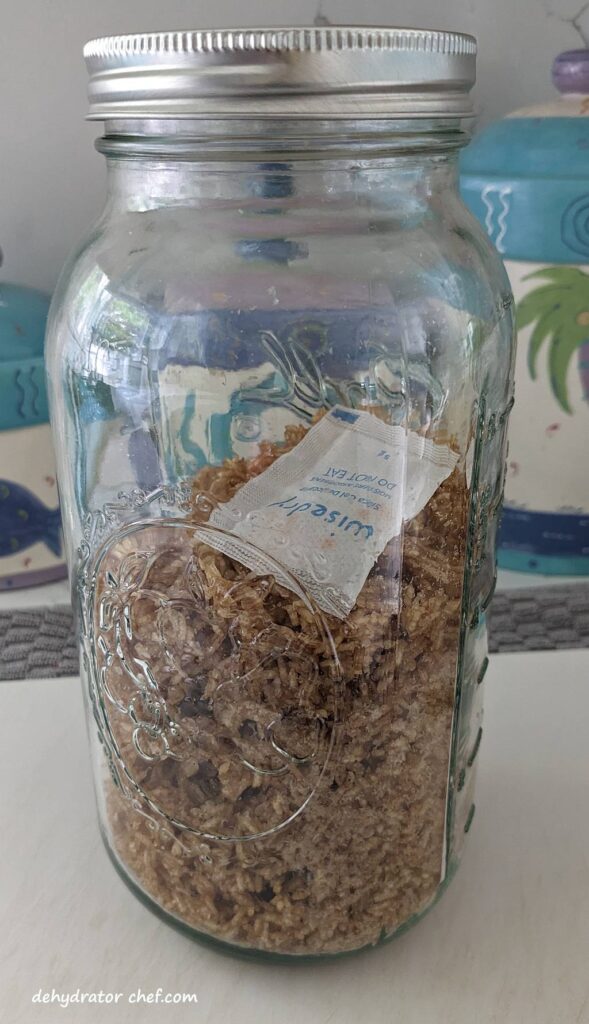
We’ll use a food-safe desiccant packet for moisture control because we live in a fairly humid area. For our pint-size or quart-size mason jars, we’ll use a single food safe 5 -gram desiccant packet. The desiccant packets will absorb any moisture and extend the shelf life of the dehydrated rice.
We use these inexpensive food-safe desiccant packets which are available from Amazon. These 5-gram packets have over 5000 of mostly 4- and 5-star customer reviews, with an average of 4.7 stars out of 5. Our bag of 60 desiccant packets will last quite a while because they can be recharged and reused multiple times. Other food-safe sizes are available.

Attach or include a short note describing the contents and the date the product was dehydrated. The note also informs us where to go in the dehydrator logbook to make another note.
Hydration
Hydrate the dried rice using roughly a 1-to-1 ratio of dehydrated rice to boiled water. Plan on at least 15 to 20 minutes to fully hydrate.
If you’re supplementing store-bought freeze-dried meals like we often do, just add a bit more boiling water to the food pouch. Use the same 1-to-1 ratio of dehydrated rice to water and account for the extra time. Most store-bought freeze-dried meals could use a little extra to bump up the calorie count.
Weights, Measures, and Serving Sizes
This information is summarized from our notes on most food dehydration efforts.
We picked up a 16-ounce bag of long-grain white rice with a 32-ounce carton of unsalted, non-fat beef stock.
Rinsed the rice under cold water using a strainer. Then, cook according to the package directions, minus the butter and salt. We ended up with about 7 cups of cooked rice.
Today, we used seven dehydrator trays with fruit roll sheet inserts. One cup of cooked rice per tray.
The dehydrator’s start time is 1340, with the thermostat temperature set to 135 °F / 57 °C.
At 1930 (7 hours later), I broke apart the bigger clumps of rice and flipped over.
At 1130 the following day (22 hours later), the rice was done.
Tray 1, one cup of dehydrated white rice, weighed 74 grams.
Tray 2, one cup of dehydrated white rice, weighed 76 grams.
Tray 3 -7 didn’t measure.
Insider Tips
Besides dehydrated meal recipes on this website, add dehydrated rice to any of your favorite freeze-dried food pouches for a bit more bulk and calories. I don’t know about you, but with some of those store-bought freeze-dried meals, I am still hungry. I need a bit more to fill me up.
Just be sure to compensate by adding additional boiled water in roughly a 1-to-1 ratio of dehydrated rice to boiling water to the freeze-dried meal and allow enough time for adequate hydration.
Practice these Dehydrator Chef homemade dehydrated camping meal recipes at home several times with the very same outdoor kitchen gear used in the field or at the campsite. This approach lets you practice your skills to know what to expect and where to adapt.
